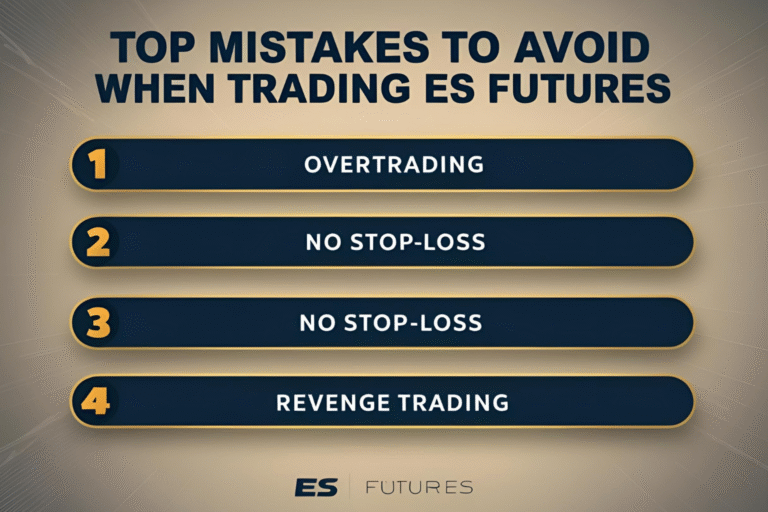Risk Management Tips for ES Futures Traders
No matter how skilled you are as a trader, consistent success in ES futures depends on risk management. The high leverage and volatility of E-mini S&P 500 contracts can magnify both gains and losses. That’s why protecting your capital must be your top priority.
This guide offers proven risk management tips for ES futures traders to help you stay in the game longer and trade smarter.
1. Use a Fixed Percentage Risk Per Trade
Risk only 1%–2% of your account balance on any single trade.
- If you have a $10,000 account, limit your loss to $100–$200
- Helps prevent large drawdowns during losing streaks
✅ Pro Tip: Use a position size calculator before every trade.
2. Always Trade with a Stop-Loss
Never enter a trade without knowing exactly where you’ll exit if wrong.
- Place your stop beyond key support/resistance
- Avoid moving stops emotionally—stick to your plan
Example: If you enter ES long at 4,800, stop at 4,790 = $500 max loss
3. Know the Tick Value and Contract Size
Each tick in ES = $12.50
- A 1-point move = 4 ticks = $50
- Large moves can happen quickly—especially during news events
Understanding how quickly losses (or profits) can accumulate helps you adjust position size accordingly.
4. Avoid Trading During Low Liquidity Hours
Risk increases when spreads widen, and volume drops.
- Avoid trading between 5:00 PM – 6:00 PM ET (daily break)
- Be cautious during holidays and overnight sessions
Stick to high-volume sessions: 9:30 AM – 11:30 AM ET and 2:00 PM – 4:00 PM ET
5. Don’t Overleverage
Just because your broker allows you to trade with $500 margin doesn’t mean you should. Always factor in:
- Your risk tolerance
- Volatility in the market
- Realistic stop-loss distance
Consider trading Micro ES (MES) if you’re still building discipline.
6. Set Realistic Profit Targets
Avoid aiming for home runs. Instead:
- Use 2:1 or 3:1 reward-to-risk ratios
- Let trades run only when conditions are in your favor
Example: Risk $100 to make $200–$300
7. Keep a Trading Journal
Document each trade:
- Entry/exit prices
- Strategy used
- Reason for trade
- Mistakes or successes
Reviewing your performance regularly helps identify patterns, errors, and opportunities to improve.
8. Use Economic Calendars
Big news events (e.g., CPI, FOMC) cause volatility spikes.
- Use tools like Forex Factory or CME Calendar
- Avoid entering new trades right before major announcements
9. Limit the Number of Trades Per Day
Overtrading is a common reason traders lose money.
- Cap yourself at 2–4 high-quality setups per session
- Focus on execution, not quantity
10. Know When to Walk Away
Losses happen—even to pros.
- Set a daily loss limit (e.g., 3% of account)
- Take breaks after 2 consecutive losses
- Never chase the market emotionally
FAQs
Q1. Why is risk management critical in futures trading?
Because ES futures are leveraged, small market moves can result in large losses without proper controls.
Q2. What’s the best risk-to-reward ratio?
Aim for at least 2:1. Risk $100 to make $200.
Q3. Should beginners use stop-loss orders?
Absolutely. Stops are your safety net, especially in fast-moving markets.
Q4. Is it okay to adjust stops after entering a trade?
Only if based on strategy—not emotion. Otherwise, stick to the original plan.
Q5. What’s better for risk management: ES or MES?
MES offers more flexibility for small accounts and tighter control over position sizing.

